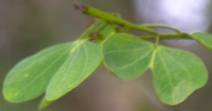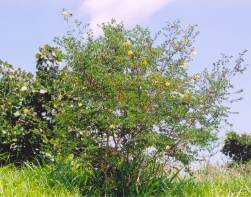Bauhinia tomentosa
Bauhinia tomentosa L
Family: Fabaceae
Common names: Yellow Bauhinia (Eng) Geelbeesklou (Afr): IsiThibathibana (Zulu)
Introduction
This medium to large shrub with its attractive, light green, two-lobed leaves produces beautiful, bright yellow flowers with black to maroon coloured centres in summer.

Description
Description
Medium to large shrub to a small tree, up to 4m in height. Leaves are divided into two lobes, light green in colour, with a leathery texture, carried on branches that are often drooping. It produces large bell-shaped, bright yellow flowers with a black to deep maroon coloured centre in mid to late summer (from December to March).

The fruits are pea like pods, slender and velvety. They are light green, turning a pale brown with age and are produced from January to June or even later. Bark is gray or brown.
Conservation Status
Status
Bauhinia tomentosa is not threatened.
Distribution and habitat
Distribution description
This plant can be found along the coastal strip from southern KwaZulu-Natal to Maputoland, Mpumalanga as well as Mozambique, Zimbabwe, tropical Africa and as far as India and Sri Lanka. It is found in woodland, riverine bush and coastal dune bush.
Derivation of name and historical aspects
History
The genus Bauhinia honours brothers from the 16th century, Johann and Caspar Bauhin, both botanists and herbalists, the paired lobes of the leaves reflecting their relationship. The species name tomentosa means 'hairy' and refers to the velvety hairy pods.

Previously a large genus, it has now been divided into a number of genera according to the flower shapes. Several South African bauhinias are in cultivation including the well-known Pride of De Kaap (Bauhinia galpinii) and the Kei Bauhinia (Bauhinia bowkeri).
Ecology
Ecology
The flowers are rich in pollen and nectar, attract various insects such as butterflies and bees. In turn these insects will attract insect eating birds. Certain birds and the larvae of certain moth species feed on the flowers. This is also a host plant for many butterfly species, with the larvae feeding on the leaves.
Uses
Use
The wood is used to make rafters for huts and the dried leaves and flower buds, and the roots and bark are used in traditional medicine in Africa and India.
Three other species of Bauhinia are also used medicinally for everything from coughs, convulsions and constipation to pneumonia and venereal diseases. (Bauhinia galpinii, Bauhinia thonningii, Bauhinia petersiana)

Growing Bauhinia tomentosa
Grow
Bauhinia tomentosa is deciduous, but can be evergreen in mild climates. The adult plants can tolerate a moderate amount of frost, but the seedlings and younger plants should be protected from frost. It prefers full sun and needs a moderate amount of water.
It can be propagated from seed and grows relatively fast. Plant it singly or in groups. It is suitable for rockeries, shrubberies, and large containers, on patios or next to swimming pools.
The soil needs to be well drained with compost added to enrich it. A covering of mulch over the soil is a good idea, replenishing the layer as regularly as possible.
References
- Joffe, P. 2001. Creative gardening with indigenous plants. Briza Publications, Pretoria.
- Pooley, E. 1993. The complete field guide to trees of Natal, Zululand and Transkei. Natal Flora Publication Trust, Durban.
- Schmidt, E., Lötter, M. & McCleland, W. 2002. Trees & shrubs of Mpumalanga and Kruger National Park. Jacana, Johannesburg.
- Van Wyk, B.-E. & Gericke, N. 2000. People's plants. Briza Publications, Pretoria.
- Van Wyk, B. & Van Wyk, P. 1997. Field guide to trees of southern Africa. Struik, Cape Town.
Credits
Lou-Nita Le Roux
Lowveld National Botanical Garden
May 2005
Plant Attributes:
Plant Type: Shrub, Tree
SA Distribution: Eastern Cape, Gauteng, KwaZulu-Natal, Limpopo, Mpumalanga
Soil type: Loam
Flowering season: Late Summer
PH: Acid
Flower colour: Yellow
Aspect: Full Sun
Gardening skill: Challenging
Special Features:
Horticultural zones







Rate this article
Article well written and informative
Rate this plant
Is this an interesting plant?
Login to add your Comment
Back to topNot registered yet? Click here to register.